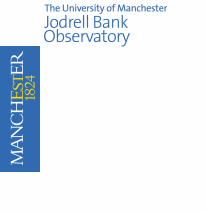PhD Projects 2005
Pulsars provide the nearest thing to a physicist's dream come true. Being the end-point of stellar evolution, they are densest bodies next to black holes and give us an insight into the most extreme physical conditions of matter density, pressure and magnetic field observable by man. They also provide the most precise clocks known to humankind for undertaking unique experiments of gravitation and general relativity. Furthermore, they can be used as probes of the distribution of ionised material and magnetic field in the Galaxy with a precision which nothing else can. We use the telescopes at Jodrell Bank, Parkes (Australia) and Arecibo (Puerto Rico) in this work and frequently travel to the foreign instruments to make observations. The pulsar group at Jodrell Bank are arguably the most productive in the world in this area and have discovered more than three-quarters of the known population of these elusive and fascinating objects.
There are several main active areas of research in the general area of pulsar astronomy which would support projects which would be ideal for students, starting in September 2005. We outline each of these areas below.
The Galactic Pulsar Population
The Parkes Multibeam pulsar survey led by Jodrell Bank's pulsar group in collaboration with the ATNF in Australia has been the most successful survey in pulsar history. Just completed, it is a sensitive survey of a 10 deg-wide strip of the Galactic plane from Galactic longitude l=260 deg to l=50 deg. Using a 13-beam receiver on the 64-m Parkes radio telescope in Australia, it has already discovered about 700 new pulsars. We expect that after processing of all data that this one survey will finally have found as many pulsars as all previous pulsar surveys put together (see red points in figure below). Obviously, the newly discovered pulsars form an extremely valuable sample for studies of Galactic population of pulsars.
The observed population is biased by certain selection effects and
does not necessarily represent the true population of pulsars in the
Galaxy. However, by modelling the well-known selection effects,
the salient properties of the underlying population (distribution
in space, spin period, magnetic fields, luminosities etc)
can be determined, allowing important
conclusions relevant for the population and evolution of massive
stars. This project would be ideal for a student with a good
background in programming, and an interest in statistical methods
in astronomy.
Please contact Dunc Lorimer (drl@jb.man.ac.uk) or
Michael Kramer (mkramer@jb.man.ac.uk) for further details.
The interstellar medium is not uniform but shows a small degree of
clumpiness in its contents of free electron. These density
fluctuations responsible for scintillation and scattering of radio
signals propagating through the interstellar medium (ISM). Scattering
of pulsar signals causes the signal to arrive from different, multiple
ray paths with different geometric lengths leading to a temporal
broadening of the pulse shape commonly known as the scatter broadening
time. Further, along different ray paths the
radiation acquires random phases which cause interference in the plane
of the observer to produce diffraction patterns which are easily
observable as intensity variations.
With the already available data significant contributions to this
project can be within a MSc project. The scope of the addressed
scientific question would allow to extend this project to a
PhD thesis.
Please contact Michael Kramer
(mkramer@jb.man.ac.uk) or Maura McLaughlin
(mclaughl@jb.man.ac.uk) for further details.
Probing the Interstellar Medium using Pulsars
